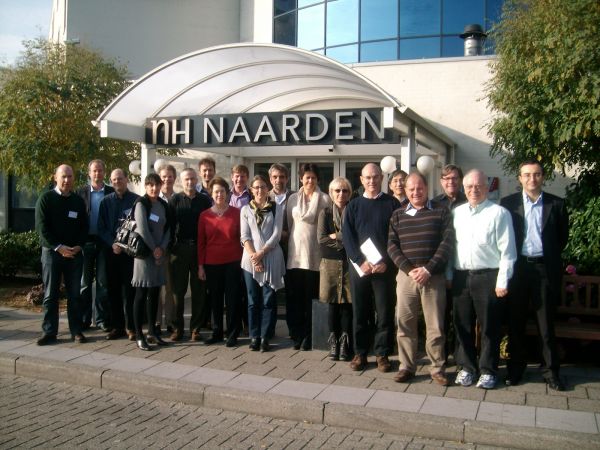Dystroglycan and Dystroglycanopathies
- Number 187
- Date 17 November 2011
Location: Naarden, The Netherlands
The 187th ENMC workshop on dystroglycan and dystroglycanopathies was held at Naarden, The Netherlands, on 11th – 13th November 2011. Nineteen participants from seven countries (Germany, Italy, Netherlands, Sweden, Switzerland, United Kingdom and the USA) with expertise in biochemistry, cell biology, structural biology, animal models of disease, genetic and clinical aspects of muscular dystrophies, clinical trials and patients’ perspectives, attended.
The aims of this workshop were to bring together researchers working on the clinical and basic aspects of the modification of dystroglycan, whether it be in relation to the disease situation in patients, animal models of human dystroglycan-related disease, or cell-based systems addressing the effects of changes or modification of dystroglycan function. Specific issues which were addressed are as follows:-
By combining clinical and basic scientists, and a range of diseases / models / cellular systems, we hoped to provide a platform for the sharing of ideas, reagents, animal models, and to fertilise novel hypotheses and open new avenues of research into these diseases for which there are as yet no forms of therapy. This workshop was the first step in generating a strong working group that is now in a position to lobby and/or bid for future EU Framework research funding, or other such calls.
Specifically the workshop recognised the difficulties in correlating the specific genetic alteration in the patient with the actual disease severity. It was agreed that better diagnostic tools were needed to assess disease severity in patients and model systems, including detection reagents to look at both the amount and the enzyme activity of the affected gene product. Considerable discussion also centred on the idea of dystroglycan as a messenger, delivering signals from the outside to the inside of the cell. The nature of the connection to the outside of the cell, the precise signal pathways activated, and the consequence of the signal generated for the cell – survival, growth, death. The current state of potential therapies including virus-mediated gene replacement and small molecule therapeutics were discussed. Finally a view from a carer of their perspective of dystroglycanopathy and the current patient registry schemes was also considered.
A full report is published in Neuromuscular Disorders (pdf)

ENMC
Lt. generaal van Heutszlaan 6
3743 JN BAARN
The Netherlands
+ 31- 35-5480481
enmc@enmc.org
We may request cookies to be set on your device. We use cookies to let us know when you visit our websites, how you interact with us, to enrich your user experience, and to customize your relationship with our website.
Click on the different category headings to find out more. You can also change some of your preferences. Note that blocking some types of cookies may impact your experience on our websites and the services we are able to offer.
These cookies are strictly necessary to provide you with services available through our website and to use some of its features.
Because these cookies are strictly necessary to deliver the website, refusing them will have impact how our site functions. You always can block or delete cookies by changing your browser settings and force blocking all cookies on this website. But this will always prompt you to accept/refuse cookies when revisiting our site.
We fully respect if you want to refuse cookies but to avoid asking you again and again kindly allow us to store a cookie for that. You are free to opt out any time or opt in for other cookies to get a better experience. If you refuse cookies we will remove all set cookies in our domain.
We provide you with a list of stored cookies on your computer in our domain so you can check what we stored. Due to security reasons we are not able to show or modify cookies from other domains. You can check these in your browser security settings.
These cookies collect information that is used either in aggregate form to help us understand how our website is being used or how effective our marketing campaigns are, or to help us customize our website and application for you in order to enhance your experience.
If you do not want that we track your visit to our site you can disable tracking in your browser here:
We also use different external services like Google Webfonts, Google Maps, and external Video providers. Since these providers may collect personal data like your IP address we allow you to block them here. Please be aware that this might heavily reduce the functionality and appearance of our site. Changes will take effect once you reload the page.
Google Webfont Settings:
Google Map Settings:
Google reCaptcha Settings:
Vimeo and Youtube video embeds:
The following cookies are also needed - You can choose if you want to allow them:
You can read about our cookies and privacy settings in detail on our Privacy Policy Page.
Privacy Policy